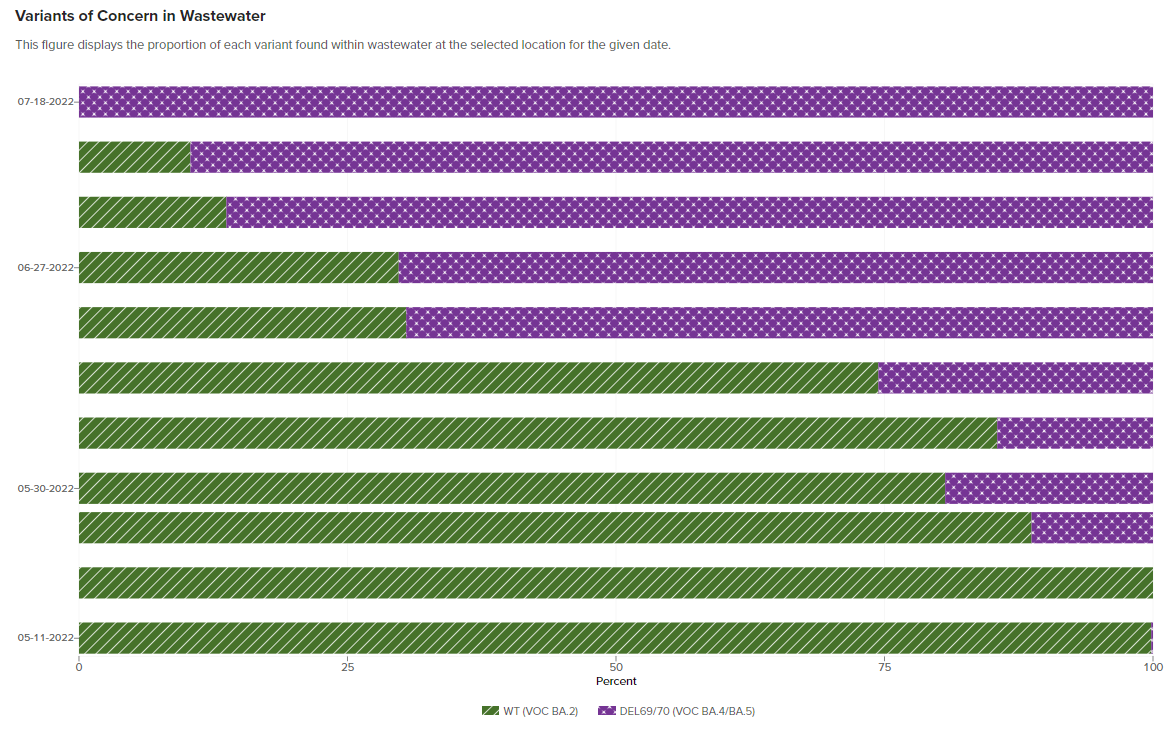Genetic sequencing from PCR tests and wastewater monitoring show the highly contagious BA.5 variant has become dominant in Alberta.

Ninety more Albertans were in hospital compared to the week before, according to the weekly COVID-19 figures released by the province on Wednesday.
As of July 25, 649 COVID-19 patients were in hospitals provincewide. ICU cases saw an increase of 3 from the week before, to 26. The provincial rate of new hospitalizations has been climbing since mid-July.
Alberta marked 13 new deaths, bringing the pandemic death toll to 4,665.
The seven-day average positivity rate on PCR tests rose to 23.3 per cent from 22.5 per cent the week prior. Positivity rates have been rising for the past month on the molecular tests that have been restricted to people with clinical risks for severe outcomes and people who live and work in high-risk settings.
Wastewater insights
The University of Calgary’s COVID-19 wastewater tracker got an upgrade on Wednesday, in time for an escalating seventh pandemic wave.
The university’s Centre for Health Informatics rolled out visualizations showing variants of concern (VOC) in the wastewater, as well as influenza virus RNA.
Kevin Frankowski, executive director of Advancing Canadian Water Assets at the University of Calgary, said the new data is meant to complement COVID-related data from the province to enable Albertans to evaluate the risk of catching the coronavirus while out in the community.
“This is really about trends – this isn’t about any specific data point – and to see what direction things are going,” he said. “It contributes to my risk-based decision making: (is the trend) going up or down or are we in a lull between waves and we can relax a little bit or does it look like they need to take full precautions and maybe make different decisions about whether I attend that concert or not.”

Get weekly health news
At launch, the VOC and influenza wastewater data was only available for certain communities around the province: Calgary area, Fort McMurray, Edson, Canmore, Drumheller, Brooks and Taber.
“Not all the locations that we currently monitor for COVID are currently being monitored for flu, but we’re working on expanding that flu monitoring throughout the province,” Frankowski said.

The Ministry of Health funds what he calls a tool that has “become a core part of the public health toolbox.”
Currently, the pan-Alberta consortium that includes the University of Alberta and municipalities tests wastewater for COVID-19 RNA for 94 per cent of the province’s urban and 80 per cent of the rural population.
BA.5 dominant in Alberta
The VOC graph shows the BA.4 and BA.5 Omicron subvariants are now making up 100 per cent of Calgary and area’s wastewater samples as of July 18, with those highly contagious and immune-evading subvariants becoming dominant in the southern Alberta city in mid-June. In mid-May, the BA.2 subvariant accounted for all of Calgary’s wastewater sampling.
Similar trends are shown in communities around the province where VOC data is available on the U of C’s website.
Wednesday’s update from the province on the pandemic showed the BA.5 subvariant became dominant in the province on around July 17.
“Typically, when a new variant displaces an old variant, that’s usually the beginning of a new wave. So I think the addition of the variant information on the public tracker allows people to have easier access to understanding whether the wave is starting or is about to break,” Frankowski said.
Frankowski said the current testing of wastewater isn’t able to differentiate between BA.4 and BA.5, the reason for the paired reporting.
“Our technical team is constantly monitoring the primers that the Center for Disease Control and others develop for these new variants,” he said. “We’re not monitoring for every single possible variant, we’re looking for viruses or variants of concern — the ones that the CDC and others have determined are likely to be important.”

Many jurisdictions around the world are in the grip of another wave fuelled by the BA.5 subvariant, with provinces like Saskatchewan acknowledging it would become the dominant variant.
Albertans under 5 still without vaccination
On July 14, a spokesperson for the Alberta government said the province expected to roll out COVID-19 vaccination for children under 5 by the end of the month.
The province did not respond to requests for an update from Global News this week.
Alberta remains one of the few provinces yet to announce how parents and children can access those pediatric vaccines.
Monitoring other diseases
The influenza wastewater data reflects data from the province on a mid-spring wave of influenza hitting Calgary and area, much later than the usual winter wave.
“Wastewater is quite accurate in terms of understanding what’s happening across the population that’s being monitored.”
Frankowski said testing wastewater could be used for pathogens like monkeypox or polio, but that depends on prioritization of resources and the desire for monitoring of various diseases.









Comments